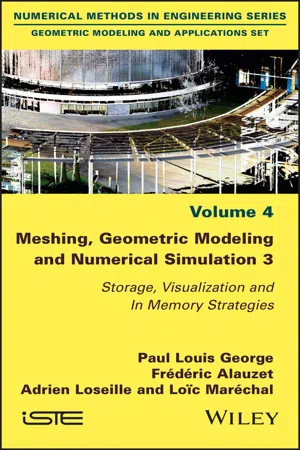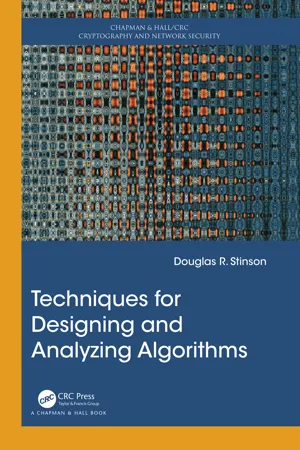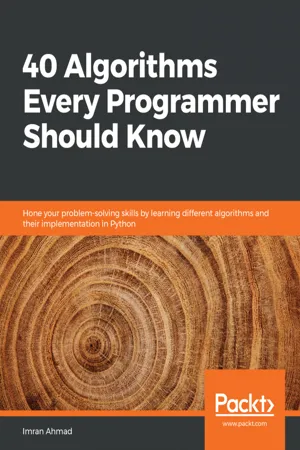Computer Science
Advanced Data Structures
Advanced data structures are complex data structures that are designed to solve specific problems efficiently. They are used to store and manipulate large amounts of data in a way that allows for fast access and retrieval. Examples of advanced data structures include trees, graphs, and heaps.
Written by Perlego with AI-assistance
Related key terms
6 Key excerpts on "Advanced Data Structures"
- eBook - ePub
Data Structures and Program Design Using Python
A Self-Teaching Introduction
- D. Malhotra, N. Malhotra(Authors)
- 2020(Publication Date)
- Mercury Learning and Information(Publisher)
CHAPTER 1INTRODUCTION TO DATA STRUCTURES1.1 INTRODUCTIONA data structure is an efficient way of storing and organizing the data elements in a computer’s memory. Data means a value or a collection of values. Structure refers to a method of organizing the data. The mathematical or logical representation of data in the memory is referred to as a data structure. The objective of a data structure is to store, retrieve, and update the data efficiently. A data structure can be considered as all the elements grouped under one name. The data elements are called members, and they can be of different types. Data structures are used in almost every program and software system. There are various kinds of data structures that are suited for different types of applications. Data structures are the building blocks of a program. For a program to run efficiently, a programmer must choose the appropriate data structures. A data structure is a crucial part of data management. As the name suggests, data management is a task that includes different activities, like the collection of data and the organization of data into structures. Data structures are used in stacks, queues, arrays, binary trees, linked lists, and hash tables.A data structure helps us to understand the relationship of one element to another element and organize it within the memory. It is a mathematical or logical representation or organization of data in the memory. Data structures are extensively applied in the following areas:• Compiler Design• Database Management Systems (DBMS)• Artificial Intelligence• Network and Numerical Analysis• Statistical Analysis Packages• Graphics• Operating Systems (OS)• SimulationsThere are many applications in which different data structures are used for their operations. Some data structures sacrifice speed for the efficient utilization of memory, while others sacrifice memory utilization and result in a faster speed. - eBook - ePub
Learn Data Structures and Algorithms with Golang
Level up your Go programming skills to develop faster and more efficient code
- Bhagvan Kommadi(Author)
- 2019(Publication Date)
- Packt Publishing(Publisher)
Data Structures and Algorithms
A data structure is the organization of data to reduce the storage space used and to reduce the difficulty while performing different tasks. Data structures are used to handle and work with large amounts of data in various fields, such as database management and internet indexing services.In this chapter, we will focus on the definition of abstract datatypes, classifying data structures into linear, nonlinear, homogeneous, heterogeneous, and dynamic types. Abstract datatypes, such as Container, List, Set, Map, Graph, Stack, and Queue, are presented in this chapter. We will also cover the performance analysis of data structures, choosing the right data structures, and structural design patterns.T he r eader can start writing basic algorithms using the right data structures in Go.Given a problem, choosing the data structure and different algorithms will be the first step. After this, doing performance analysis is the next step. Time and space analysis for different algorithms helps compare them and helps you choose the optimal one - eBook - ePub
Meshing, Geometric Modeling and Numerical Simulation 3
Storage, Visualization and In Memory Strategies
- Paul Louis George, Frédéric Alauzet, Adrien Loseille, Loïc Maréchal(Authors)
- 2020(Publication Date)
- Wiley-ISTE(Publisher)
1.1. Basic data structures and basic techniques
These structures range from a totally basic level (a simple single-index array) to significantly higher levels of sophistication. Operations with the structures are based on a number (quite small) of basic techniques. The algorithms are going to be built with the best use of these structures and techniques.1.1.1. Basic data structures
It is virtually impossible to be exhaustive and there are numerous references on this subject, but we thought it might be useful to describe some of the basic structures intensively used in algorithms, starting with the simplest, the array. In a formal way, given a set of values (mainly integers and floating-point numbers1 ), a data structure is an organization in the memory allowing these values to be stored. With this organization, and according to its nature, access methods are associated (how the sixth value contained in an array can be accessed, how the next value is accessed, etc.) as well as manipulating methods (how value is removed or added to a list, etc.).Before proceeding, let us indicate that the values stored in any such structure are often integers that characterize objects (a point, an edge, a face or a mesh, etc.) but do not only think of an array of coordinates or an array of solutions.• ArrayAn array is a contiguous portion of memory in which values are stored successively one after the other. Accessing a value is direct, via its index (single-index array) or via its indices (vectors, matrices, etc.). In the case of a single-index array, the user sees the ith value of the array Tab, denoted by vi , as and the following value is given as: vi + 1= Tab (i + 1). In memory, if the array starts at address adr and if each value occupies b memory words, then vi , the ith value, starts at address adr + (i—1)b - eBook - ePub
Engineering Informatics
Fundamentals of Computer-Aided Engineering, Second Edition
- Benny Raphael, Ian F. C. Smith(Authors)
- 2013(Publication Date)
- Wiley(Publisher)
In some engineering fields, work has concentrated on standardizing data structures. Data structure standardization helps contribute to better communication between engineers during complex engineering tasks. Such standardization also increases compatibility between software products. Increases in productivity that are linked to such efforts could result in better, faster and cheaper engineering activities.This chapter presents and describes fundamental types of data structures. Knowledge of these types is important for understanding the material presented in subsequent chapters on object-oriented programming (Chapter 4), database concepts (Chapter 5) and constraint-based reasoning (Chapter 7), as well as optimization and search (Chapter 8).3.2 Definitions
The term data structure refers to the organization of data within software applications. Properly organized data is easy to understand and maintain. Consider the list of variables shown in Figure 3.1a . Compare it with the structured form of the same data shown in Figure 3.1b . In structured form, logically related data are grouped together. Such structure helps understanding, thereby increasing the reliability of appropriate data use and modifications.Figure 3.1Data structures group related information together: (a) a flat list of unorganized data; (b) structured dataData structures often involve hierarchies, called decomposition hierarchies, where data are organized into attributes of systems, components and subcomponents. In this chapter, the term object will be used informally to refer to a collection of data that is organized into attributes. The term attribute is used in a generic sense to denote characteristic aspects of objects (properties) as well as components of objects. Thus an attribute might itself be an object consisting of subattributes. Figure 3.2 illustrates the decomposition of the data structure in Figure 3.1b - Douglas R. Stinson(Author)
- 2021(Publication Date)
- Chapman and Hall/CRC(Publisher)
Chapter 3Data Structures
DOI: 10.1201/9780429277412-3We assume that most students studying design and analysis of algorithms have taken a prior course in basic data structures. However, we thought it would be helpful to provide a treatment of some basic data structures, for the purpose of review and reference. Therefore, in this chapter, we discuss various aspects of linked lists, stacks, queues, priority queues, binary search trees and hash tables.3.1 Abstract Data Types and Data Structures
In our algorithms, we make use of various kinds of abstract data types, such as stacks, queues, priority queues, etc. We usually think of an abstract data type (or ADT) as consisting of a mathematical model (which typically describes a certain collection of data) together with one or more operations defined on that model. We can define an ADT and then use its operations in an algorithm as needed. On the other hand, when we write a computer program that implements a particular algorithm, we would also have to implement the ADT using a suitable data structure.Typical examples of data structures include arrays, linked lists, binary trees, etc. We study these in the following sections of this chapter. A data structure is generally more closely tied to a specific programming language than an ADT is. However, as usual, we present algorithms associated with data structures using structured pseudocode, which could subsequently be implemented using various high-level computing languages.If we want to analyze the complexity of an algorithm, then we need to be aware of the complexity of the operations in any ADTs used by the algorithm. Of course the complexity of ADT operations may depend on the specific data structure used to implement the ADT. However, many commonly used ADTs also have standard implementations in which the complexities of the operations in the ADT are predetermined.- eBook - ePub
40 Algorithms Every Programmer Should Know
Hone your problem-solving skills by learning different algorithms and their implementation in Python
- Imran Ahmad(Author)
- 2020(Publication Date)
- Packt Publishing(Publisher)
can be ordered left to right in an ascending order in which the nodes at the same level will increase in value while traversing from left to right.Passage contains an image
Practical examples
An abstract data type tree is one of the main data structures that are used in developing decision trees as will be discussed in Chapter 7 ,Traditional Supervised Learning Algorithms. Due to its hierarchical structure, it is also popular in algorithms related to network analysis as will be discussed in detail in Chapter 6 , Unsupervised Machine Learning Algorithms . Trees are also used in various search and sort algorithms where divide and conquer strategies need to be implemente d.Passage contains an image
Summary
The nextIn this chapter, we discussed data structures that can be used to implement various types of algorithms. After going through this chapter, I expect that you should be able to select the right data structure to be used to store and process data by an algorithm. You should also be able to understand the implications of our choice on the performance of the algorithm.
Learn about this page
Index pages curate the most relevant extracts from our library of academic textbooks. They’ve been created using an in-house natural language model (NLM), each adding context and meaning to key research topics.





